First, I'd like to apologize for this poor question and I hope it doesn't upset anyone here. Since I'm not that good at speaking English to convey my request, so please have a look to the cited links in order to get a clear explanation to this question.
I'm trying to find the solution to this question of mine. I started my attempt by searching for the same number in column A and column B (Debit and Credit). I used the looping-trough-array method to do it instead of employing the Find function like this question since I think it's faster.
Suppose that I have the following set data in Sheet1 and start from row 1 column A:
D e b i t Cr e d i t
20 13
14 13
13 14
14 17
19 19
11 20
17 14
20 12
19 19
20 15
20 12
13 11
12 19
13 20
19 19
20 11
11 16
10 16
19 19
20 11
Now, I'd like to process the data set above to something like this:
Basically, I need to find the same value of debit and credit in a specific row and match it with debit and credit in another row. Column C (Row) indicates the matched values. For example, the debit value in row 2 match with the credit value in row 15 and vice-versa. And numbers in column D (ID Match) are the label numbers to indicate the order of the matched data that's found first. This is my code in an attempt to implement the task:
Public i As Long, j As Long, k As Long, Last_Row As Long
Public DC, Row_Data, ID_Match
Sub Quick_Match()
T0 = Timer
k = 0
Last_Row = Cells(Rows.Count, "A").End(xlUp).Row
ReDim DC(1 To Last_Row - 1, 1 To 2)
ReDim Row_Data(1 To Last_Row - 1, 1 To 1)
ReDim ID_Match(1 To Last_Row - 1, 1 To 1)
DC = Range("A2:B" & Last_Row)
For i = 1 To Last_Row - 1
If DC(i, 1) <> "" Then
k = k + 1
For j = 1 To Last_Row - 1
If DC(i, 1) <> DC(i, 2) Then
If DC(i, 1) = DC(j, 2) And DC(i, 2) = DC(j, 1) Then
Call Row_Label
Exit For
Else
Row_Data(i, 1) = "No Match"
End If
Else
If i <> j Then
If DC(i, 1) = DC(j, 1) And DC(i, 2) = DC(j, 2) Then
Call Row_Label
Exit For
Else
Row_Data(i, 1) = "No Match"
End If
End If
End If
Next j
End If
If Row_Data(i, 1) = "No Match" Then
k = k - 1
End If
Next i
Range("C2:C" & Last_Row) = Row_Data
Range("D2:D" & Last_Row) = ID_Match
InputBox "The runtime of this program is ", "Runtime", Timer - T0
End Sub
Sub Row_Label()
Row_Data(i, 1) = j + 1
ID_Match(i, 1) = k
Row_Data(j, 1) = i + 1
ID_Match(j, 1) = k
DC(i, 1) = ""
DC(i, 2) = ""
DC(j, 1) = ""
DC(j, 2) = ""
End Sub
Though it's a bit slow on its performance, but it works fine. It completes in about 25 seconds on my machine for processing 10,000 rows of data (the data set file can be downloaded on this link for testing the running time of your code and mine). So I'm wondering if there is a more effective way for doing this. Could anyone come up with either a shorter version or a quicker version? Please do share your attempt.



